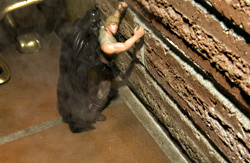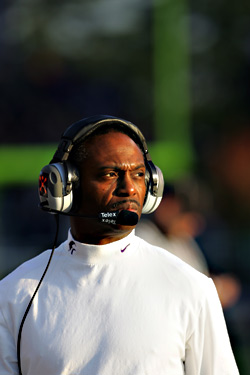Mayor Greg Nickels was talking pedestrian safety with the media one morning last week in Beacon Hill, one of those made-for-television moments with motorcycle cops chasing down errant drivers on South Columbian Way for the cameras—a morality play and sting operation all in one.
When Nickels finished, he was asked about a seemingly very different moral dilemma: the forthcoming electoral fight over exotic dancers. At issue are his proposed new restrictions on strip clubs, namely that dancers must perform at least 4 feet away from patrons, strip clubs must be lit as brightly as the inside of a supermarket, and patrons cannot hand tips directly to dancers. Against the backdrop of a half-finished sidewalk, Nickels—fresh from telling the news crews that cars need to keep a safe distance from school children—segued perfectly into the new topic.
“I’m sure we can work the 4-foot rule into this,” he joked.
But the 4-foot rule is no joke, at least to lap dancers, who aren’t climbing off their customers without a fight. To wit, strip club owners collected over twice the requisite number of signatures to place Referendum 1 on the November ballot, an attempt to render the mayor’s anti-boner rules null and void. Managing this campaign is Tim Killian, a recovering Mormon who once served a two-year church mission in Puerto Rico.
The outcome of this vote will tell you far more about the cultural temperature in Seattle than Cantwell-McGavick or the roads levy. It will determine whether the Gen-X and Gen-Y “creative class” is now in charge of the urban vibe, or if baby boomers can still mandate line dancing for all. As it is, the city that gave the world grunge rock, heroin chic, and Internet porn software already has some of the country’s strictest laws when it comes to erotic environs (you can’t even drink in Seattle’s strip clubs). By the logic of the five City Council members who approved the mayor’s newer, stricter rules last December, the city’s four strip clubs are dens of vice and prostitution—their patrons cast as louts who disturb Seattle’s urban slumber. Yet Seattle police have, in recent years, paid tens of thousands of dollars for vice detectives’ club entrance fees and lap dances—and have zero prostitution convictions to show for it.
Perhaps most telling is that not even the Seattle Planning Commission, usually a rubber stamp for the mayor, supports Nickels’ rules. Two weeks ago, the commission issued a report that said Nickels hadn’t proved his contention that strip clubs are a gateway to urban mayhem. The commission also stated that it made more sense to allow potential new strip clubs to be located throughout the city, rather than crammed into a de facto red-light district south of Safeco Field, as the mayor had proposed.
The Planning Commission’s argument may not have gone over well in quasi-suburban West Seattle and Phinney Ridge, but in neighborhoods like Capitol Hill, the reaction has been more like “bring ’em on.” That can happen only if Referendum 1 succeeds. In this case, a “Yes” vote means you like Nickels’ nanny-state rules; while “No” means you’re happy with the relatively tame status quo. Killian points to polling his strip-club funded group, Seattle Citizens for Free Speech, has done, which shows that 72 percent of Seattleites are fine with the idea of strip clubs operating within the city limits (the poll doesn’t get into how stringent a set of rules strip clubs should adhere to).
Then there’s the strip club situation in Portland, Ore., a city of 550,000 people that has its relationship with its seamy side squared away rather like pre-Giuliani New York City. The Rose City is home to some three dozen strip joints, many of them little more than mom-and-pop storefronts in dynamic neighborhoods. These businesses have thrived under Oregon’s liberal state constitution—which compels municipalities to regulate strip clubs as though they are candy stores—and hasn’t led to the kind of civic rot that Nickels and others fear would infest Seattle. Moreover, property values aren’t exactly cratering in Portland’s posh Pearl District, despite its proximity to adult clubs in adjacent Old Town. Nor is the county jail awash in strippers charged with administering hand jobs, or alleged mafioso doing time for dropping bags of cash on the doorstep of City Hall (Strippergate, R.I.P).
Two hours after Nickels’ press roundup, I passed Déjà Vu on First Avenue. Directly behind the club, an excavator was breaking ground on yet another downtown condo tower. This one will be 38 stories high with units starting at $1 million, including the lower floor units for which that prized Puget Sound perspective is obscured. But even those units will have a view: the entrance to Déjà Vu. Last year, units in the same project were advertised as beginning in the low $700,000s. A 40 percent pre-opening price increase next to an alleged sin bin doesn’t exactly make the case that strip clubs are wrecking Seattle.







